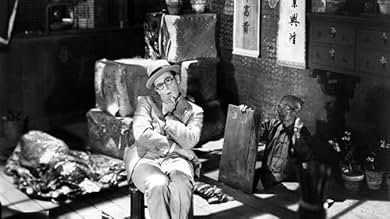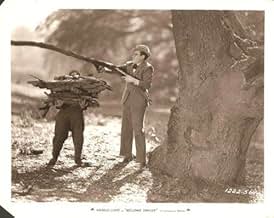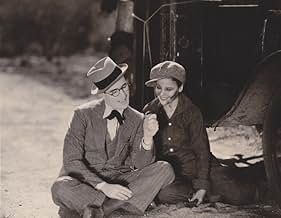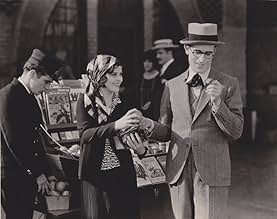Agrega una trama en tu idiomaHarold Bledsoe, a botany student, is called back home to San Francisco, where his late father had been police chief, to help investigate a crime wave in Chinatown.Harold Bledsoe, a botany student, is called back home to San Francisco, where his late father had been police chief, to help investigate a crime wave in Chinatown.Harold Bledsoe, a botany student, is called back home to San Francisco, where his late father had been police chief, to help investigate a crime wave in Chinatown.
- Dirección
- Guionistas
- Elenco
Charles Middleton
- John Thorne aka The Dragon
- (as Chas. Middleton)
Will Walling
- Police Captain Walton
- (as William Walling)
Grady Sutton
- Man at Party (silent version)
- (escenas eliminadas)
Brooks Benedict
- Handcuffed Prisoner at Police Station
- (sin créditos)
Eddy Chandler
- Cop
- (sin créditos)
Rae Daggett
- Woman Sitting in Police Station
- (sin créditos)
Douglas Haig
- Buddy Lee
- (sin créditos)
Edgar Kennedy
- SFPD Desk Sergeant
- (sin créditos)
Tetsu Komai
- Florist Henchman
- (sin créditos)
Wang Lee
- Chinaman with Queue
- (sin créditos)
James B. Leong
- Florist Henchman
- (sin créditos)
- …
Jim Mason
- Barry Steele
- (sin créditos)
- …
Nelson McDowell
- 1st Train Passenger
- (sin créditos)
Soo Hoo Sun
- Dead Chinese Man
- (sin créditos)
James Wang
- Dr. Chang Gow
- (sin créditos)
Opiniones destacadas
Anyone who's seen `Singin' In The Rain' knows the panic engendered by the arrival of sound in Hollywood. Virtually overnight, the accepted methods and styles of filmmaking had to change to accommodate the new technology, and comedies were perhaps affected most of all. Instead of relying on wild car chases, broad gestures and sight gags, movies now had to include verbal comedy of the sort that wouldn't fit neatly onto title cards, and the dialogue had to be delivered with comic timing, since it was being heard rather than read off the screen. The most remarkable thing about this movie is how easily Harold Lloyd seemed to navigate this conversion to sound. The dialogue is clever, naturalistic, well-delivered and well-recorded, and the music has obviously been scored to support the action, and all this a matter of months after the first appearance of sound technology in Hollywood! The difference in technique is apparent when you compare the broader, overdubbed silent scenes with Clancy the cop and the somewhat more subtle, sound scenes at the police station and with Billie Lee.
As a side note, notice how the character of the Chinese doctor is treated respectfully, and even the black henchman of the Dragon, apparently invulnerable except for his glass shins, isn't the usual stereotype we expect in movies of the period. On the minus side, the movie is overlong and could have done without the opening sequence involving Lloyd and his `disguised' girlfriend. But overall, this is an enjoyable comedy and an interesting record of Hollywood's transition to sound.
As a side note, notice how the character of the Chinese doctor is treated respectfully, and even the black henchman of the Dragon, apparently invulnerable except for his glass shins, isn't the usual stereotype we expect in movies of the period. On the minus side, the movie is overlong and could have done without the opening sequence involving Lloyd and his `disguised' girlfriend. But overall, this is an enjoyable comedy and an interesting record of Hollywood's transition to sound.
How many bludgeonings can you have in a movie before it ceases to be funny? My five year old and I might disagree on this, but I think that Harold Lloyd crossed that subtle line in this movie. It started off cute and funny, but quickly became sadistic. Compared to Hot Water and Safety Last, this was a poor comedy; however, compared to the Three Stooges or The Ritz Brothers, it wasn't bad.
Maybe hitting several dozen Chinese immigrants in the head with a club was funnier back then...
Maybe hitting several dozen Chinese immigrants in the head with a club was funnier back then...
There are actually two different versions of this film available. Yes, Lloyd re-shot a lot of his silent footage and released it as a "talkie". But he also released the silent version to the overseas markets and to theaters not yet wired for sound. While the story remains the same, the two versions are quite different in several areas.
I recently had the privilege of seeing the silent version restored by Jere Gulden of the UCLA Film & Television archives with a new score by Robert Israel at the Motion Picture Academy.
I enjoyed it. While not as good as the classic Lloyd films like "Safety Last", "The Freshman" and my personal favorite, "The Kid Brother", it's still pretty good and I think is superior to the sound version, particularly in the use of music. Also, it seems like once Lloyd found sound, sometimes he didn't know when to shut up. There are some nice moments in the sound version, but by 1928 Lloyd really knew what he was doing with silence and I think this version is superior.
Barbara Kent provides a nice, though tiny love interest (her bio says she was only 4'11). The scene in which Lloyd, without knowing she is the girl in the picture, goes on and on how beautiful she is, is heart warming and romantic. It plays so much better in the silence. Kent was brought back for Lloyd's "Feet First".
Just a note: the great Edgar Kennedy only appears in the sound version. He replaces the desk Sargent from the silent movie.
Hopefully they will soon release both versions on one DVD, similar to what they did with the two versions of "The Big Sleep" (war and post war versions).
I recently had the privilege of seeing the silent version restored by Jere Gulden of the UCLA Film & Television archives with a new score by Robert Israel at the Motion Picture Academy.
I enjoyed it. While not as good as the classic Lloyd films like "Safety Last", "The Freshman" and my personal favorite, "The Kid Brother", it's still pretty good and I think is superior to the sound version, particularly in the use of music. Also, it seems like once Lloyd found sound, sometimes he didn't know when to shut up. There are some nice moments in the sound version, but by 1928 Lloyd really knew what he was doing with silence and I think this version is superior.
Barbara Kent provides a nice, though tiny love interest (her bio says she was only 4'11). The scene in which Lloyd, without knowing she is the girl in the picture, goes on and on how beautiful she is, is heart warming and romantic. It plays so much better in the silence. Kent was brought back for Lloyd's "Feet First".
Just a note: the great Edgar Kennedy only appears in the sound version. He replaces the desk Sargent from the silent movie.
Hopefully they will soon release both versions on one DVD, similar to what they did with the two versions of "The Big Sleep" (war and post war versions).
Welcome Danger was Harold Lloyd's first talkie, and the transition was not an easy one. Well, easier compared to those of Keaton and Chaplin, but Lloyd's silent pratfalls are poorly paced for a soundie and the film is desperately overlong. This is best reserved for hardcore Lloydites--beginners are advised to check out his mid to late twenties silents before investigating his talkies, of which this is the weakest.
5woid
As you might have read here, this movie bridges silents and sound, having been shot without sound, and reshot when sound arrived -- and it appears that little of the silent material was used. There are silent-style titles between scenes, but basically we're watching an early sound film.
Sadly, like many early sound films, it's bogged down by the clumsy technology. The camera is static and actionless... in a Harold Lloyd movie! Harold has few action scenes, or even moments, for most of the film. Meanwhile, his character, speaking for the first time, turns out to be a smart-aleck, not at all like his sympathetic silent persona. Add to that the many moments when he bops somebody on the head or kicks them in the pants, which in sound comes off as painful more than comic. And the fact that he keeps casually destroying other people's property with no motivation makes him come off as, well, kind of a jerk.
Sound quality is not bad for the primitive era, but many scenes are obviously redubbed. And the dialogue! It's inane, which is bad enough. But worse, it's painfully slow, mostly overpronounced in projected, stage-actory voices. As a result, the film drags on at an adagio pace for just short of two hours. Way too long for any comedy.
And to read, again here, that it was previewed at THREE HOURS, tells me that this must have been one of the classic ill-fated Hollywood productions.
And yet... There are some real treats here. Edgar Kennedy is great as the irascible desk sergeant. He's on screen for a long time, but unbilled. Meanwhile, prominent billing goes to Charles Middleton as the weaselly John Thorne. This pleased me because four years later, Middleton and Kennedy both appeared (not together) in one of the one or two greatest comedies ever made, Duck Soup.
In Duck Soup, Kennedy has a series of great scenes -- as the lemonade salesman with Harpo, followed by Harpo, Chico, and the hat-and-leg-swapping routine. And when Freedonia goes to war, he gets to sit on Harpo in the bath.
Meanwhile, Charles Middleton, third-billed here, has merely a bit in Duck Soup, as the prosecutor at Chicolini's trial, playing straight man to Chico and Groucho. Short, but like every moment of Duck Soup, sublime.
Out of respect to the greatness of Harold Lloyd, I can't give this less than a five. But no more, either. It's for diehards & completists only. I'm one myself, but this is a long, hard slog.
Sadly, like many early sound films, it's bogged down by the clumsy technology. The camera is static and actionless... in a Harold Lloyd movie! Harold has few action scenes, or even moments, for most of the film. Meanwhile, his character, speaking for the first time, turns out to be a smart-aleck, not at all like his sympathetic silent persona. Add to that the many moments when he bops somebody on the head or kicks them in the pants, which in sound comes off as painful more than comic. And the fact that he keeps casually destroying other people's property with no motivation makes him come off as, well, kind of a jerk.
Sound quality is not bad for the primitive era, but many scenes are obviously redubbed. And the dialogue! It's inane, which is bad enough. But worse, it's painfully slow, mostly overpronounced in projected, stage-actory voices. As a result, the film drags on at an adagio pace for just short of two hours. Way too long for any comedy.
And to read, again here, that it was previewed at THREE HOURS, tells me that this must have been one of the classic ill-fated Hollywood productions.
And yet... There are some real treats here. Edgar Kennedy is great as the irascible desk sergeant. He's on screen for a long time, but unbilled. Meanwhile, prominent billing goes to Charles Middleton as the weaselly John Thorne. This pleased me because four years later, Middleton and Kennedy both appeared (not together) in one of the one or two greatest comedies ever made, Duck Soup.
In Duck Soup, Kennedy has a series of great scenes -- as the lemonade salesman with Harpo, followed by Harpo, Chico, and the hat-and-leg-swapping routine. And when Freedonia goes to war, he gets to sit on Harpo in the bath.
Meanwhile, Charles Middleton, third-billed here, has merely a bit in Duck Soup, as the prosecutor at Chicolini's trial, playing straight man to Chico and Groucho. Short, but like every moment of Duck Soup, sublime.
Out of respect to the greatness of Harold Lloyd, I can't give this less than a five. But no more, either. It's for diehards & completists only. I'm one myself, but this is a long, hard slog.
¿Sabías que…?
- TriviaBegan shooting as a silent in August, 1928 at Metropolitan Studios, it would become an agonizingly long and complicated production. It was finally released on October 12, 1929 as a talkie after largely being re-shot with another director - Clyde Bruckman as a talkie (marking the first time Lloyd worked from a script) and painstakingly edited down from an original 16-reels (some 2 hours and forty-five minutes) to 12-reels. The silent version cost $521,000 and another $281,000 was spent on the sound negative. While the novelty of hearing Lloyd speak made it his largest grossing hit since The Freshman (1925), those steep production costs resulted in a huge drop in net profits from his earlier features.
- ErroresAfter the dish washing scene ends between Harold and Billlie and the screen goes dark, CUT! can clearly be heard before the next scene begins.
- Citas
Billie Lee: I just put my foot in the wrong place.
Harold Bledsoe: Oh, you did. Well, if you do it again, I'll put my foot in the right place!
- Versiones alternativasThere is an all-silent version of this film distributed to unwired cinemas which includes more of the original "silent" version and is adapted with inter-titles for the newer sound sequences.
- ConexionesFeatured in American Masters: Harold Lloyd: The Third Genius (1989)
Selecciones populares
Inicia sesión para calificar y agrega a la lista de videos para obtener recomendaciones personalizadas
Detalles
Taquilla
- Presupuesto
- USD 979,828 (estimado)
- Tiempo de ejecución1 hora 53 minutos
- Color
Contribuir a esta página
Sugiere una edición o agrega el contenido que falta

Principales brechas de datos
What is the Spanish language plot outline for Welcome Danger (1929)?
Responda





























